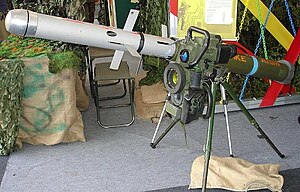Spike (Missile)
| Spike | |
|---|---|

Spike ATGM Command & launcher unit (CLU) with mock-up Spike-LR missile mounted on a tripod at Singapore Army Open House 2007
|
|
| Type | Anti-tank missile |
| Place of origin | Israel |
| Service history | |
| In service |
1981–present (Spike NLOS) 1997–present |
| Used by | See Operators |
| Wars | 1982 Lebanon War, Second Intifada, Iraq War, 2006 Lebanon War, War in Afghanistan (2001–present), Gaza War, 2014 Israel–Gaza conflict |
| Production history | |
| Designed | Late 1970s (Spike NLOS) |
| Manufacturer |
Rafael Advanced Defense Systems Diehl BGT Defence (Now part of Rheinmetall Defence Electronics) Bharat Dynamics |
| Produced |
Early 1980s – present (Spike NLOS) 1997–present |
| Variants | See versions |
| Specifications | |
| Weight |
Spike-ER from helicopter: |
| Length | 1,670 mm (5 ft 6 in) (Missile w/launcher) |
| Diameter | 170 mm (6.7 in) (Missile w/launcher) |
|
|
|
| Rate of fire | Ready to launch in 30 seconds, reload in 15 seconds |
| Effective firing range | 1.5 km (Spike-SR) 2.5 km (Spike-MR) 4 km (Spike-LR) 8 km (Spike-ER) 25 km (Spike NLOS) |
| Sights | 10× optical sight |
| Warhead | Tandem-charge HEAT warhead |
|
Detonation
mechanism |
Impact |
|
|
|
| Engine | Solid-fuel rocket |
|
Guidance
system |
Infrared homing – Electro Optical (CCD, IR or Dual CCD/IIR), Passive CCD or dual CCD/IIR seeker |
| Mini Spike Anti-personnel guided weapon | |
|
|
|
|
|
1981–present (Spike NLOS)
Early 1980s – present (Spike NLOS)
Spike-ER from helicopter:
• Missile in canister: 34 kg (74 lb 15 oz)
• Launcher: 55 kg (121 lb 4 oz)
• Launcher + 4 missiles: 187 kg (412 lb 4 oz)
Spike-MR/LR from ground:
• Missile round: 14 kg (30 lb 14 oz)
• Command & launch unit (CLU): 5 kg (11 lb 0 oz)
• Tripod: 2.8 kg (6 lb 3 oz)
• Battery: 1 kg (2 lb 3 oz)
Spike is an Israeli fourth generation man-portable fire-and-forget anti-tank guided missile and anti-personnel missile with a tandem-charge HEAT warhead, developed and designed by the Israeli company Rafael Advanced Defense Systems. As of 2016, some 25,600 missiles of the Spike family have been sold to 25 nations.
As well as engaging and destroying targets within the line-of-sight of the launcher ("fire-and-forget"), some variants of the missile are capable of making a top-attack profile through a "fire, observe and update" guidance method; the operator tracking the target, or switching to another target, optically through the trailing fiber-optic wire (or RF link in the case of the vehicle-mounted, long-range NLOS variant) while the missile is climbing to altitude after launch. This is similar to the lofted trajectory flight profile of the US FGM-148 Javelin.
Spike is a fire-and-forget missile with lock-on before launch and automatic self-guidance. The missile is equipped with an imaging infrared seeker.
The medium, long and extended range versions of the Spike also have the capability of "Fire, Observe and Update" operating mode. The missile is connected by a fiber-optical wire that is spooled out between the launch position and the missile. With this, the operator can obtain a target if it is not in the line of sight of the operator at launch, switch targets in flight, or compensate for the movement of the target if the missile is not tracking the target for some reason. Hence, the missile can be fired speculatively for a target of opportunity, or to provide observation on the other side of an obstacle. The missile has a soft launch capability – the motor firing after the missile has left the launcher – that allows for the missile to be fired from confined spaces, which is a necessity in urban warfare.
...
Wikipedia
